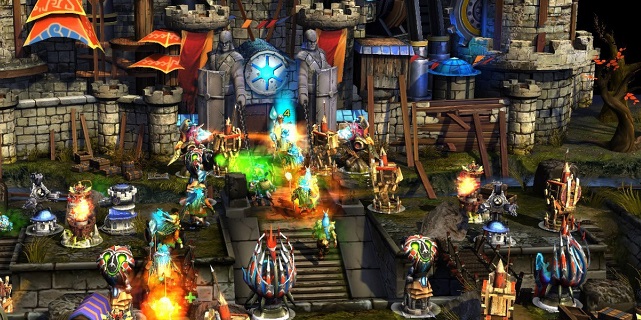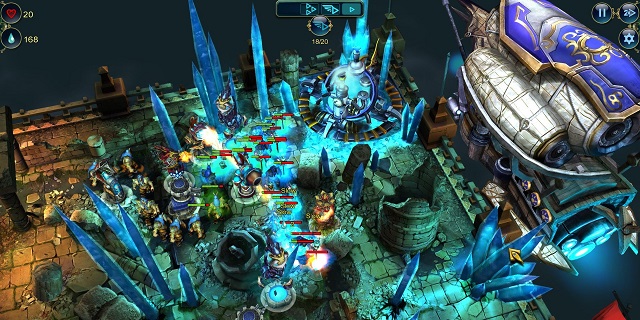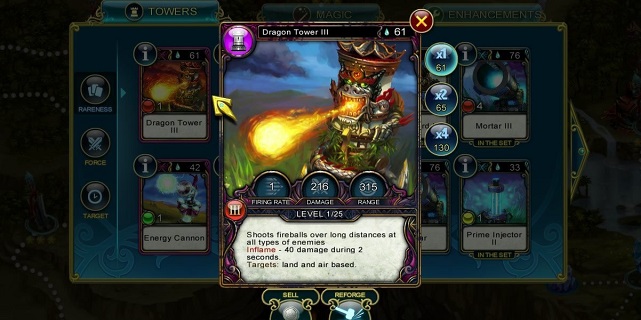
There are a lot of things in games that are just not fun. Getting absolutely decimated because your equipment is too weak is not fun. Steamrolling the enemy because your equipment is too strong is fun once and then never again. And more than anything else, grinding easy missions hoping for a rare drop is not fun — particularly when that rare drop will take you straight from getting handily beaten to absolutely wiping out the enemy.
Prime World: Defenders has a lot of interesting ideas. It’s fun to collect cards, and the random aspect of it opens the possibility that none of my friends will choose (or be able) to approach a level quite like I do. There’s a strategic layer not seen in many other tower defense games, as the player must examine the enemy composition and choose his towers based on that. A limited set of cards can be brought into any given battle, which is nice, too. I like making those sorts of choices and living with them after the first wave has started. What I don’t like? Realizing after the wave has started that I could not have made the right choice because it hasn’t dropped for me yet, and the towers I’ve been able to upgrade will simply never be effective against that particular enemy type.

Completing a level results in a random card, some silver and potentially some stars. The role of the card is obvious: it goes into the player’s deck for use in later levels. The silver and stars are both currency. Silver is used to evolve and fuse cards in the deck to make stronger versions of them. Both processes are important, because the level-one towers aren’t effective for long.
Evolution allows you to take two level-one slowing tower cards and combine them to create a single level-two slowing tower card. There’s no downside to doing this, as you should only take one of any given card into a level. Fusion allows you to make cards more powerful without increasing their level by sacrificing other cards. Some of these cards are fusion cards which have no other use, but you can sacrifice any other cards as well. This can be dangerous, since the cards are used up in a fusion, but after the poison tower is at maximum level, getting one randomly isn’t a complete waste. Stars are used to buy booster packs from the shop.
This is where it feels like Prime World: Defenders starts asking for real money, but it never does. You’ve bought the game; you get access to everything it has to offer. There is no way to trade dollars for stars. I suspect there was at some point in development, because of how much a single new card can turn the tide of a level, how grindy the levels are and because you are, in effect, buying booster packs of unknown cards for a premium currency in the hopes that you’ll unwrap the new, most powerful card in your deck.

Mechanically, Prime World: Defenders is a competent tower defense game. It’s not my preference, as I prefer more opportunities to maze, but what’s here is presented well. Tower types are varied, and both towers and monsters are well-animated. Sound design is atrocious, however, and I sincerely hope to never hear the phrase “I wish they’d given me a better tower” again. Either make the units say something useful or don’t let them say anything at all, because in the heat of the moment that quip doesn’t offer the player anything useful. Everywhere else the game takes itself very seriously, but as soon as a level starts, the people manning the towers all think it’s open-mic night at the local comedy club.
The mazing really irks me, as well. On most levels there is a set path for the monsters to walk, and a grid of squares around that path for the player to put towers on. It’s not my favorite setup, but it works. A little bit later, light mazing is introduced, allowing the player to alter the paths the monsters take.
What bothers me here, though, is that only certain squares on the monster’s path are available to put a tower on. I understand the design choice to disallow the player from closing off all paths to the enemy objective. What I don’t understand is not allowing me to place towers wherever I want otherwise on levels designed for it. If you’re going to introduce the concept and have boss encounters rely on it, then the player ought to be afforded the freedom to place towers wherever he thinks it makes sense to do so. Limiting options like this really makes encounters reek of “we beat this level in a specific way in the design phase, and you need to stumble upon it as well.”
Tower defense is a fairly saturated game type, and I can’t recommend this one when games like Anomaly 2, Cubemen 2 and Sanctum 2 are out there. Each presents a different take on the genre, and all are more fun than Prime World: Defenders. It’s a shame, because there are neat concepts here that just never quite mesh together properly.
Pros: Combining a CCG with tower defense is an interesting idea, microtransactions are avoided
Cons: Mazing is infuriating, glacial game pace is exacerbated by the need to grind for just the right card



















